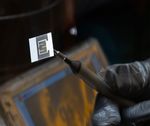Ivent Solutions Market Trend Update - August 2021
←
→
Page content transcription
If your browser does not render page correctly, please read the page content below
Ivent Solutions Market Trend Update August 2021 Solar Panels Maintain Pricing and Get Even More Powerful Photovoltaic Panel Cost per Watt The solar industry has spent decades slashing the cost of generating electricity direct from the sun. Now it’s focusing on making panels even more powerful. With savings in equipment manufacturing hitting a plateau and more recently pressured by rising prices of raw materials, producers are stepping up work on advances in technology — building better components and employing increasingly sophisticated designs to generate more electricity from the same- sized solar farms. “The first 20 years in the 21st century saw huge reductions in module prices, but the speed of the reduction started to level off noticeably in the past two years,” said Xiaojing Sun, global solar research leader at Wood Mackenzie Ltd. “Fortunately, new technologies will create further cost-of- electricity reductions.” A push for more powerful solar equipment underscores how further cost reductions remain essential to advance the shift away from fossil fuels. While grid-sized solar farms are now typically cheaper than even the most advanced coal or gas-fired plants, additional savings will be required to pair clean energy sources with the expensive storage technology that’s needed for around-the-clock carbon-free power. Bigger factories, the use of automation and more efficient production methods have delivered economies of scale, lower labor costs and less material waste for the solar sector. The average cost of a solar panel dropped by 90% from 2010 to 2020.
Ivent Solutions Market Trend Update August 2021 Boosting power generation per panel means developers can deliver the same amount of electricity from a smaller-sized operation. That is potentially crucial as the cost of land, construction, engineering and other equipment haven’t fallen in the same way as panel prices. It can even make sense to pay a premium for more advanced technology. “We are seeing people willing to pay a higher price for a higher wattage module that lets them produce more power and make more money off their land,” said Jenny Chase, lead solar researcher at BloombergNEF. Higher-powered systems are already arriving. Through much of the past decade, most solar panels produced a maximum of about 400 watts of electricity. In early 2020, companies began selling 500-watt panels, and in June, China-based Risen Energy Co. introduced a 700-watt model. “More powerful and highly-efficient modules will reduce costs throughout the solar project value chain, supporting our outlook for significant sector growth over the next decade,” Fitch Solutions analysts said in a research note last month. Here are some of the ways that solar companies are super-charging panels… Perovskites: While many current developments involve tweaks to existing technologies, perovskite promises a genuine breakthrough. Thinner and more transparent than polysilicon, the material that’s traditionally used, perovskite could eventually be layered on top of existing solar panels to boost efficiency, or be integrated with glass to make building windows that also generate power. “We will be able to take solar power to the next level,” said Kim Dohyung, principal researcher on a perovskite project team at Korea Electric Power Corp., one of several companies experimenting with the material. “Ultimately, this new technology will enable us to make a huge contribution in lowering greenhouse gas emissions.” Adoption of perovskite has previously been challenged by costs and technical issues that prevented commercial-scale production. There are now signs that’s changing: Wuxi UtmoLight Technology Co. in May announced plans to start a pilot line by October with mass production beginning in 2023.
Ivent Solutions Market Trend Update August 2021 Massachusetts-based 1366 Technologies Inc., which makes wafers for solar cells, last month said it's merging with Hunt Perovskite Technologies LLC. The new company, called CubicPV, combines two complementary technologies that offer the potential to create more efficient panels. It plans to produce photovoltaic products that will use Hunt’s perovskite technology, layered atop a silicon wafer developed by 1366. Bi-Facial Panels Solar panels typically get their power from the side that faces the sun, but they can also make use of the small amount of light that reflects back off the ground or backsheet. Bi-facial panels started to gain in popularity in 2019, with producers seeking to capture the extra increments of electricity by replacing opaque backing material with specialist glass. They were also temporarily boosted by a since- closed loophole in the U.S. that exempted them from tariffs. The trend caught solar glass suppliers off-guard and briefly caused prices for the material to soar. Late last year, China loosened regulations around glass manufacturing capacity, and that should prepare the ground for more widespread adoption of the two-sided solar technology. Ivent’s main solar panel assembly provider, WSL Solar, manufactures product using the LG range of bi-facial cells.
Ivent Solutions Market Trend Update August 2021 Doped Polysilicon Another change that can deliver an increase in power is shifting from positively charged silicon material for solar panels to negatively charged, or n-type, products. N-type material is made by doping polysilicon with a small amount of an element with an extra electron like phosphorous. It is more expensive… but can be as much as 3.5% more powerful than the material that currently dominates the market. The products are expected to begin taking market share in 2024 and be the dominant material by 2028, according to PV-Tech. In the solar supply chain, ultra-refined polysilicon is shaped into rectangular ingots, which are in turn sliced into ultra-thin squares known as wafers. Those wafers are wired into cells and pieced together to form solar panels. Big Wafers, Better Cells For most of the 2010’s, the standard solar wafer was a 156-millimeter (6.14 inches) square of polysilicon, about the size of the front of a CD case. Now, companies are making the squares bigger to boost efficiency and reduce manufacturing costs. Producers are pushing 182- and 210-millimeter wafers, and the larger sizes will grow from about 19% of the market share this year to more than half by 2023, according to Wood Mackenzie’s Sun. The factories that wire wafers into cells — which convert electrons excited by photons of light into electricity — are adding new capacity for designs like heterojunction or tunnel‐oxide passivated contact cells. While more expensive to make, those structures allow the electrons to keep bouncing around for longer, increasing the amount of power they generate.
Ivent Solutions Market Trend Update
August 2021
What are Perovskite Solar Cells?
Solar cells with efficiencies above 20% and produced at low cost are a difficult proposition,
however perovskites are among the most promising new materials for solar cells to meet
this target. Photovoltaics research focuses on halide perovskites that contain both organic
and inorganic compounds and, hence, are considered hybrid semiconductors. "In less than
one decade, these perovskites underwent an outstanding development. Meanwhile,
perovskite solar cells convert more than 20% of the incident light directly into usable
current," says photovoltaics expert Dr. Michael Hetterich. The vast potential of perovskites
is also obvious from tandem solar cells that combine a semi-transparent perovskite top cell
with a silicon or copper-indium-gallium-diselenide (CIGS) bottom cell. This allows for an
optimal use of the solar spectrum.Ivent Solutions Market Trend Update August 2021 NZD versus AUD - AU$0.945 vs NZ$1.00 NZD versus USD - US$0.695 vs NZ$1.00 NZD versus EUR - EU$0.590 vs. NZ$1.00 Copper - USD9600 / tonne Lead - USD2400 / tonne Nickel - USD19900 / tonne
August 29, 1831 – English scientist Michael Faraday discovers electromagnetic induction. Electromagnetic induction is the primary principle behind electric motors and electric generators, two very important inventions that power and drive our electronic technology of today. August 5, 1858 – After four failed attempts, American merchant Cyrus West Field succeeds in completing the first successful transatlantic telegraph cable. Completed approximately two months after construction began, the cable is only operational for just over a month. However, this cable proved the feasibility of transatlantic communications and Cyrus West Field raised new funds to complete the first permanent telegraph line in 1866. August 9, 1898 – The US Patent Office awards patent 608,845 to Rudolf Diesel for his diesel internal combustion engine. August 30, 1969 – The first Interface Message Processor (IMP) is delivered to Leonard Kleinrock’s research group at UCLA. The IMP was the device that would interconnect networks between research facilities on the developing ARPANET, the precursor to the Internet. As a packet-switching device, the IMP can be considered the first generation of what we now call network routers. August 1, 1986 – Apple discontinues production of the Macintosh XL, effectively ending the life of the Apple Lisa computer platform. In January of 1985, the Macintosh line of computers was gaining momentum but the Lisa line of computers was not selling well. In order to salvage what they could from the Lisa and offer a more powerful Macintosh computer, Apple created the Macintosh XL model by modifying a Lisa 2/10 computer to run the Macintosh operating system. August 27, 2003 – The city of Fairbanks, Alaska connected to what was at the time the world’s largest battery backup. Designed to help prevent serious blackouts that plagued the city every two to three years, the batteries could provide power to the city for a few minutes – enough time to start up the city’s backup diesel generators. The battery contains 13,760 cells covering more than 10,000 square feet. It was reported that in the first two years of operation, the battery system prevented at least 81 power failures. August 19, 2004 – Google holds its Initial Public Offering (IPO) selling over 22 millions shares at a starting price of $85. Google shares closed that day at $100.34 and the IPO created many instant millionaires and a few billionaires. August 4, 2007 NASA launches the Mars Phoenix lander. Phoenix would become the first spacecraft to land on the Martian arctic surface. Its mission was to dig for ice and assess if the Martian arctic ever had conditions that could have supported life.
You can also read



























































